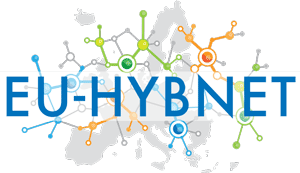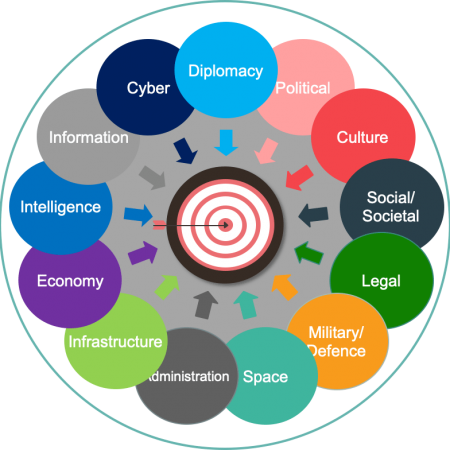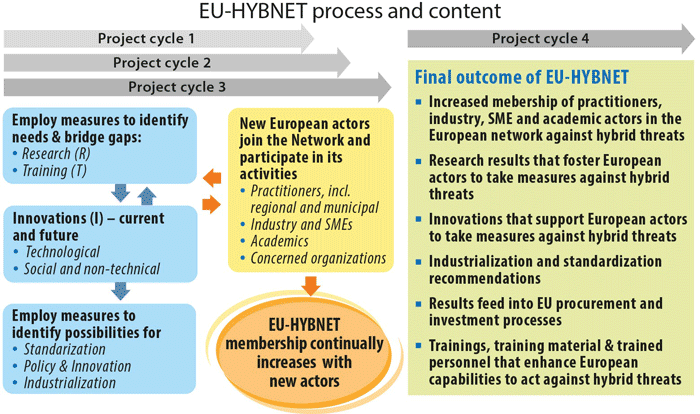
EU-HYBNET
Empowering a Pan-European Network to Counter Hybrid Threats

Empowering a Pan-European Network to Counter Hybrid Threats
EU-HYBNET (Empowering a Pan-European Network to Counter Hybrid Threats) project is funded by the European Union’s Horizon 2020 research and innovation programme under grant agreement No883054.
The project aims at enriching the existing European networks countering hybrid threats and ensuring long term sustainability. This will be achieved by defining the common requirements of European practitioners’ and other relevant actors in the field of hybrid threats. Ultimately, this can fill knowledge gaps, deal with performance needs, and enhance capabilities or research, innovation and training endeavours concerning hybrid threats.
EU-HYBNET will monitor developments in research and innovation activities as applied to hybrid threats; so to indicate priorities for innovation uptake and industrialization and to determine priorities for standardization for empowering the Pan-European network to effectively counter hybrid threats.
EU-HYBNET will establish conditions for enhanced interactions with practitioners, industry, and academia for a meaningful dialogue and for increasing membership in the network.
EU-HYBNET (Empowering a Pan-European Network to Counter Hybrid Threats) project aims to empower its network to fight against hybrid threats by proliferating knowledge and facilitating cooperation between industry, practitioners and academia, and by providing advanced solutions for network collaboration and delivering recommendations for training, standardization and industrialization of cutting-edge innovations.
The main project objectives are:
To enrich the existing network countering hybrid threats and ensure long term sustainability
To define common requirements that can fill knowledge gaps, deal with performance needs, and enhance capabilities of research, innovation and training endeavours concerning hybrid threats.
To monitor developments in research and innovation activities as applied to hybrid threats.
To indicate priorities for innovation uptake and industrialisation and to determine priorities for standardisation for empowering the Pan-European network to effectively counter hybrid threats.
To establish conditions for enhanced interaction with practitioners, industry and academia for meaningful dialogue and for increasing membership in the network
To foster capacity building and knowledge exchange on countering hybrid threats
To create a basis for establishing effective synergies with existing European, national and sub-national networks of practitioners and other actors countering hybrid threats
The four project core themes, together with the cycle approach, represent the leading multidisciplinary methodological principles of the project. They create windows for EU-HYBNET to focus on European actors’ awareness, gaps in both understanding and countering and needs for capacity building to strengthen resilience and counter hybrid threats as well to deliver tailor made solutions. Each of the four project core themes identified starts with mapping event to see what is missing and what is needed. The whole process is facilitated by the use of innovative collaboration platforms.
These themes link and interface with other hybrid threat domains identified and defined by the Commission/JRC and provide a sound window into supporting research and innovation activities in any of the hybrid threat domains considered by the project to be important and capable of delivering solutions during execution of the project cycles.
In short, the project relies on a fixed but flexible approach in its focus on hybrid threat challenges and provides a comprehensive multidisciplinary methodological approach in delivering needed solutions and recommendations concerning innovations and their uptake, including standardisation. The domains and interfaces of hybrid threats in relation to the four project core themes are in line with the Commission’s characterization of hybrid threat domains.
To analyse trends has become even more vital than before due to the changed security environment. Hybrid Threats are by character difficult to detect. However, without detection, countering becomes difficult and responses might always be two steps behind. Hybrid threats also have an ever-changing nature. Approach seldom repeats itself and combination of tools is tailor made for the target. For this reason, analysis relating to different security related trends will be essential to be able to have foresight and build early warning systems.
Hybrid threat trend analysis needs to be multidisciplinary and multidimensional using also scenario based thinking. The future trends of hybrid threats cover also the three other EU-HYBNET themes connecting them to wider security context. This will strengthen situational awareness and identify new and emerging capability needs for countering hybrid threats.
At present, cyber is treated as a domain of activity or knowledge where there are no rules. With regards to hybrid threats specifically, cyber and future technologies are key components through which new developments produce not only new kinds of hybrid threats, but also act as powerful countering measures in the fight against such threats.
Todays’ technological upheavals and those of the future suggest that the portfolio of tools used in the realm of hybrid threats will continue to expand rapidly. Computers are ubiquitous, and getting smaller, while processing power is increasing at enormous rates. Other fundamental breakthroughs include robotics, nano- and bio-technologies, artificial intelligence, sensor and 5G technologies. Taken together, these technologies connect symbiotically with people; and they structure society in all spheres – from the interpersonal to the social, and to the military.
To be sure, communication technologies are driving these developments, there is still a great deal to learn about how an adversary can make use of these new tools and technologies, how cyber is connecting areas previously not connected to realm of security, like hospitals, and how we can in fact use these same tools to detect and counter hybrid threats.
Civilians are central as targets and as actors seeking human and societal security. Too much focus has been placed on the state/government level when it comes to hybrid threats. There is still too little research on how this plays out in hybrid threat security environment. Having a better understanding of where the potential vulnerabilities lie within possible target societies enables these same societies – and the diverse civilians within them – to develop measures that can build trust and solidarity within them, making them less vulnerable to such manipulations. This understanding will also help in resilience building that is important for all the EU member states.
Civilians are not passive recipients of information or governmental guidance, and trust levels between the governed and government need re-examination. In a democratic society, political decision-making and the opinions of residents are influenced. Various methods are also combined in order to reach the objective of influencing more effectively. This is a normal, deliberative political activity. Just as there is social or communicative influence that cannot be classified as a threat, there is also governmental influence, i.e. diplomacy. However, outside interference and influence may sometimes be a threat. Classifying something as a threat constitutes normative classification: a threat is something unwanted, i.e. something that is deemed to be wrong or evil. Threats can often easily be classified in the legal sense: in many cases, they are a criminal activity.
A considerable proportion of the political decisions that affect people’s everyday lives are made by municipal boards and councils, and municipalities are in charge of social services, health care and education for example. Law enforcement agencies might be in the frontline when it comes to detecting and countering hybrid threats. Many cases in the recent history have shown us that the local level can play a crucial role both in countering and enabling hybrid threats.
Information, strategic communication and propaganda are among the areas that, together with cyber, have been linked to hybrid threats most often. The range of hostile and covert influence activities employed in the past include falsely attributed or non-attributed press materials, leaks, the development and control of media assets, overt propaganda, unattributed and black propaganda, forgeries, disinformation, the spread of false rumors, and clandestinely supported organisations, among others. These activities are recognized to be part of the hybrid playbook.
Internet and social media channels have changed the game board for covert influence actions, providing a fertile context for the massive dissemination of overt and covert propaganda by hostile States and non-governmental groups: anyone can produce and disseminate content; connections, funders and identities are blurred; information flows are huge; the speed of information dissemination is breathtaking. AI-generated audiovisual forgeries and the likely future improvements in deep fakes technology appear on the horizon as an insidious threat for democracies that will require developing analytic capabilities to detect and counter them. All these require a sound understanding of communication processes and information flows, developing analytic capabilities and skills for assessing open sources and content, raising strong disinformation awareness, critical thinking, and media literacy, and building positive narratives instead of being on the defensive.
While social media networks provide an unprecedented dimension for adversely impacting the potential exposure of target audiences, gathering empirical evidence on disinformation content is required for a full understanding of the effects of influencing campaigns, and thus developing effective strategies and tactics to counter influence.
Each of the four project core themes have a vision that encompasses the variety of challenges that EU MSs may face when countering hybrid threats in targeted domains and interfaces with other domains. These visions are based on current European high-level research.

To achieve the objectives of the project, we will apply an iterative approach, consisting of three full scale project cycles in three core activity areas:I) research (incl. training), II) innovation monitoring, and III) recommendations for standardisation and innovation uptake (including industrialisation). Additionally, in a concluding fourth cycle, the project will collect results from each of the previous three cycles, draw conclusions, and make suitable recommendations. The figure below depicts the structure of the principal activities of EU-HYBNET. Each cycle will employ measures of high quality that will allow for agile responses to the proliferation of hybrid threats by continually increasing the network’s membership with professionals that will be trained to deal with hybrid threats and have the potential to enhance European capabilities along the same lines
